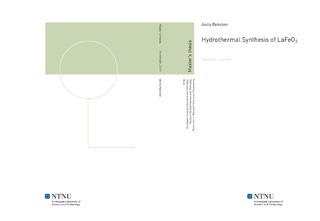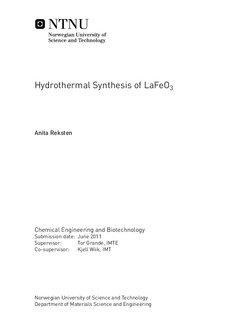| dc.contributor.advisor | Grande, Tor | nb_NO |
| dc.contributor.advisor | Wiik, Kjell | nb_NO |
| dc.contributor.author | Reksten, Anita | nb_NO |
| dc.date.accessioned | 2014-12-19T13:25:55Z | |
| dc.date.available | 2014-12-19T13:25:55Z | |
| dc.date.created | 2012-04-20 | nb_NO |
| dc.date.issued | 2011 | nb_NO |
| dc.identifier | 517082 | nb_NO |
| dc.identifier | ntnudaim:6529 | nb_NO |
| dc.identifier.uri | http://hdl.handle.net/11250/248944 | |
| dc.description.abstract | This work explores the hydrothermal synthesis of LaFeO3 (LFO) nanorods with a high aspect ratio. Synthesis of rod shaped LFO is a stepping stone to the synthesis of strontium doped LFO (LSF) nanorods with high aspect ratio. These LSF rods can be used to structure and increase the area of dense LSF oxygen permeable membranes, which can be applied in the partial oxidation of methane for the production of synthesis gas. Obtaining a larger surface area can increase the oxygen transport through the membrane when the transport is limited by surface exchange reactions. Increasing the oxygen transport is the objective of the work. LFO was attempted synthesised by a direct and a two-step synthesis. Product morphology and phase composition have been explored by the use of SEM and XRD. In the direct synthesis the effect of potassium hydroxide concentration, molar ratio of iron to lanthanum and synthesis duration were varied to investigate the effect of these parameters. LFO was not produced in the direct synthesis; the products consisted of La(OH)3 and Fe2O3. Since LFO was not obtained, a calculation exploring the temperature where LFO become more stable than La(OH)3 and Fe2O3 was performed. The calculations show that the transition temperature where LFO is thermodynamically favoured is close to the operating synthesis temperature. The small driving force for formation of LFO at a temperature close to the transition temperature is the reason why LFO have not formed in the direct syntheses.The two-step method consists of hydrothermal synthesis of La(OH)3 nanorods, which were covered by iron nitrate solution and attempted converted into LFO by a topochemical reaction. In the study performed, the rod structure is lost when the product is calcined at 400 ºC. LFO is not observed formed at this temperature, and LFO nanorods were therefore not obtained in the two-step synthesis. | nb_NO |
| dc.language | eng | nb_NO |
| dc.publisher | Institutt for materialteknologi | nb_NO |
| dc.subject | ntnudaim:6529 | no_NO |
| dc.subject | MTKJ Industriell kjemi og bioteknologi | no_NO |
| dc.subject | Materialer for energiteknologi | no_NO |
| dc.title | Hydrothermal Synthesis of LaFeO3 | nb_NO |
| dc.type | Master thesis | nb_NO |
| dc.source.pagenumber | 109 | nb_NO |
| dc.contributor.department | Norges teknisk-naturvitenskapelige universitet, Fakultet for naturvitenskap og teknologi, Institutt for materialteknologi | nb_NO |

